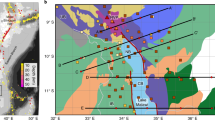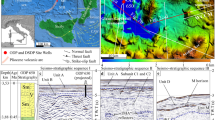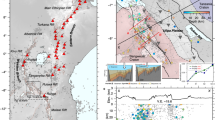Abstract
Investigations of a variety of continental rifts and margins worldwide have revealed that a considerable volume of melt can intrude into the crust during continental breakup1,2,3,4,5,6,7,8, modifying its composition and thermal structure. However, it is unclear whether the cause of voluminous melt production at volcanic rifts is primarily increased mantle temperature or plate thinning1,2,8,9,10,11,12. Also disputed is the extent to which plate stretching or thinning is uniform or varies with depth with the entire continental lithospheric mantle potentially being removed before plate rupture13,14,15,16. Here we show that the extensive magmatism during rifting along the southern Red Sea rift in Afar, a unique region of sub-aerial transition from continental to oceanic rifting, is driven by deep melting of hotter-than-normal asthenosphere. Petrogenetic modelling shows that melts are predominantly generated at depths greater than 80 kilometres, implying the existence of a thick upper thermo-mechanical boundary layer in a rift system approaching the point of plate rupture. Numerical modelling of rift development shows that when breakup occurs at the slow extension rates observed in Afar, the survival of a thick plate is an inevitable consequence of conductive cooling of the lithosphere, even when the underlying asthenosphere is hot. Sustained magmatic activity during rifting in Afar thus requires persistently high mantle temperatures, which would allow melting at high pressure beneath the thick plate. If extensive plate thinning does occur during breakup it must do so abruptly at a late stage, immediately before the formation of the new ocean basin16.
This is a preview of subscription content, access via your institution
Access options
Subscribe to this journal
Receive 51 print issues and online access
$199.00 per year
only $3.90 per issue
Buy this article
- Purchase on Springer Link
- Instant access to full article PDF
Prices may be subject to local taxes which are calculated during checkout



Similar content being viewed by others
References
White, R. & McKenzie, D. Magmatism at rift zones: the generation of volcanic continental margins and flood basalts. J. Geophys. Res. 94, 7685–7729 (1989)
White, R. et al. Lower-crustal intrusion on the North Atlantic continental margin. Nature 452, 460–464 (2008)
Hammond, J. O. S. et al. The nature of the crust beneath the Afar triple junction: evidence from receiver functions. Geochem. Geophys. Geosyst. 12, Q12004 (2011)
Keranen, K., Klemperer, S. L. & Gloaguen, R. EAGLE Working Group. Three-dimensional seismic imaging of a protoridge axis in the Main Ethiopian rift. Geology 32, 949–952 (2004)
Wright, T. J. et al. Magma-maintained rift segmentation at continental rupture in the 2005 Afar dyking episode. Nature 442, 291–294 (2006)
Bastow, I. D., Pilidou, S., Kendall, J-M. & Stuart, G. W. Melt-induced seismic anisotropy and magma assisted rifting in Ethiopia: evidence from surface waves. Geochem. Geophys. Geosyst. 11, QOAB05 (2010)
Thybo, H. & Nielsen, C. A. Magma-compensated crustal thinning in continental rift zones. Nature 457, 873–876 (2009)
McKenzie, D. & Bickle, M. J. The volume and composition of melt generated by extension of the lithosphere. J. Petrol. 29, 625–679 (1988)
Nielsen, T. K. & Hopper, J. R. From rift to drift: mantle melting during continental breakup. Geochem. Geophys. Geosyst. 5, Q07003 (2004)
Boutilier, R. R. & Keen, C. E. Small-scale convection and divergent plate boundaries. J. Geophys. Res. 104, 7389–7403 (1999)
Armitage, J. J., Collier, J. S. & Minshull, T. A. The importance of rift history for volcanic margin formation. Nature 465, 913–917 (2010)
Shillington, D. J. et al. Abrupt transition from magma-starved to magma-rich rifting in the eastern Black Sea. Geology 37, 7–10 (2009)
Rychert, C. A. et al. Volcanism in the Afar Rift sustained by decompression melting with minimal plume influence. Nature Geosci. 5, 406–409 (2012)
Huismans, R. & Beaumont, C. Depth-dependent extension, two-stage breakup and cratonic underplating at rifted margins. Nature 473, 74–78 (2011)
Esedo, R., van Wijk, J., Coblentz, D. & Meyer, R. Uplift prior to continental breakup: indication for removal of mantle lithosphere? Geosphere 8, 1078–1085 (2012)
Bastow, I. D. & Keir, D. The protracted development of the continent–ocean transition in Afar. Nature Geosci. 4, 248–250 (2011)
Hayward, N. J. & Ebinger, C. J. Variations in the along-axis segmentation of the Afar Rift system. Tectonics 15, 244–257 (1996)
McKenzie, D. Some remarks on the development of sedimentary basins. Earth Planet. Sci. Lett. 40, 25–32 (1978)
Rooney, T. O., Herzberg, C. & Bastow, I. D. Elevated mantle temperature beneath East Africa. Geology 40, 27–30 (2012)
Ferguson, D. J. et al. Recent rift related volcanism in Afar, Ethiopia. Earth Planet. Sci. Lett. 292, 409–418 (2010)
Pik, R., Deniel, C., Coulon, C., Yirgu, G. & Marty, B. Isotopic and trace element signatures of Ethiopian flood basalts: evidence for plume-lithosphere interactions. Geochim. Cosmochim. Acta 63, 2263–2779 (1999)
Hoffman, C. et al. Timing of the Ethiopian flood basalt event and implications for plume birth and global change. Nature 389, 838–841 (1997)
McKenzie, D. & O’Nions, K. G. Partial melt distributions from inversion of rare earth element concentrations. J. Petrol. 32, 1021–1091 (1991)
Herzberg, C. et al. Temperatures in ambient mantle and plumes: constraints from basalts, picrites, and komatiites. Geochem. Geophys. Geosyst. 8, Q02006 (2007)
Eagles, G., Gloaguen, R. & Ebinger, C. J. Kinematics of the Danakil microplate. Earth Planet. Sci. Lett. 203, 607–620 (2002)
Wolfenden, E., Ebinger, C., Yirgu, G., Renne, P. R. & Kelley, S. P. Evolution of a volcanic rifted margin: southern Red Sea, Ethiopia. Geol. Soc. Am. Bull. 117, 846–864 (2005)
Dick, H. J. B., Lin, J. & Schouten, H. An ultraslow-spreading class of ocean ridge. Nature 426, 405–412 (2003)
Jarvis, G. T. & McKenzie, D. Sedimentary formation with finite extension rates. Earth Planet. Sci. Lett. 48, 42–52 (1980)
Bown, J. W. & White, R. S. Effect of finite extension rate on melt generation at rifted continental margins. J. Geophys. Res. 100, 18011–18029 (1995)
Lee, C.-T. A., Luffi, P., Plank, T., Dalton, H. & Leeman, W. P. Constraints on the depths and temperatures of basaltic magma generation on Earth and other terrestrial planets using new thermobarometers for mafic magmas. Earth Planet. Sci. Lett. 279, 20–33 (2009)
Le Roux, V., Lee, C.-T. A. & Turner, S. J. Zn/Fe systematics in mafic and ultramafic systems: implications for detecting major element heterogeneities in the Earth’s mantle. Geochim. Cosmochim. Acta 74, 2779–2796 (2010)
Canil, D. Vanadium in peridotites, mantle redox and tectonic environments: Archean to present. Earth Planet. Sci. Lett. 195, 75–90 (2002)
Kress, V. C. & Carmichael, S. E. The compressibility of silicate liquids containing Fe203 and the effect of composition, temperature oxygen fugacity and pressure on their redox states. Contrib. Mineral. Petrol. 108, 82–92 (1991)
Field, L. et al. Integrated field, satellite and petrological observations of the November 2010 eruption of Erta Ale. Bull. Volcanol. 74, 2251–2271 (2012)
Asimow, P. & Longhi, J. The significance of multiple saturation points in the context of polybaric near-fractional melting. J. Petrol. 45, 2349–2367 (2004)
Workman, R. K. & Hart, S. R. Major and trace element composition of the depleted MORB mantle (DMM). Earth Planet. Sci. Lett. 231, 53–72 (2005)
McDonough, W. F. & Sun, S.-S. The composition of the Earth. Chem. Geol. 120, 223–253 (1995)
White, R. S., McKenzie, D. & O'Nions, R. K. Oceanic crustal thickness from seismic measurements and rare earth element inversions. J. Geophys. Res. 97, 19683–19715 (1992)
Gibson, S. A. & Geist, D. Geochemical and geophysical estimates of lithospheric thickness variation beneath Galápagos. Earth Planet. Sci. Lett. 300, 275–286 (2010)
Robinson, J. A. C. & Wood, B. J. The depth of the spinel to garnet transition at the peridotite solidus. Earth Planet. Sci. Lett. 164, 277–284 (1998)
Kojitani, H. & Akaogi, M. Melting enthalpies of mantle peridotite: calorimetric determinations in the system CaO-MgO-Al2O3-SiO2 and application to magma generation. Earth Planet. Sci. Lett. 153, 209–222 (1997)
White, N. & Bellingham, P. A two-dimensional inverse model for extensional sedimentary basins. 1. Theory. J. Geophys. Res. 107, 2259 (2002)
Acknowledgements
We acknowledge help and support by members of the NERC Afar Rift Consortium. This project was supported by a NERC consortium grant. D.J.F. acknowledges support from a LDEO postdoctoral fellowship.
Author information
Authors and Affiliations
Contributions
D.J.F., D.M.P., J.D.B. and G.Y. planned the project and conducted fieldwork in Afar. Geochemical analysis and modelling was by D.J.F., J.M., D.M.P., J.D.B. and T.P. and S.M.J. did the numerical rifting model. D.J.F. took the lead in writing the manuscript with contributions from I.D.B., J.M., D.K., S.M.J. and others.
Corresponding author
Ethics declarations
Competing interests
The authors declare no competing financial interests.
Supplementary information
Supplementary Figures
This file contains Supplementary Figures 1-3. (PDF 114 kb)
Supplementary Data
This file contains 2 tables of geochemical data. (XLSX 61 kb)
Rights and permissions
About this article
Cite this article
Ferguson, D., Maclennan, J., Bastow, I. et al. Melting during late-stage rifting in Afar is hot and deep. Nature 499, 70–73 (2013). https://doi.org/10.1038/nature12292
Received:
Accepted:
Published:
Issue Date:
DOI: https://doi.org/10.1038/nature12292
This article is cited by
-
Structure of the crust and lithospheric mantle beneath the central main Ethiopian rift
Acta Geophysica (2022)
-
Volcanic activity and hazard in the East African Rift Zone
Nature Communications (2021)
-
Evidence of active magmatic rifting at the Ma’Alalta volcanic field (Afar, Ethiopia)
Bulletin of Volcanology (2021)
-
Imaging the Ethiopian Rift Region Using Transdimensional Hierarchical Seismic Noise Tomography
Pure and Applied Geophysics (2021)
-
Melt-induced buoyancy may explain the elevated rift-rapid sag paradox during breakup of continental plates
Scientific Reports (2018)
Comments
By submitting a comment you agree to abide by our Terms and Community Guidelines. If you find something abusive or that does not comply with our terms or guidelines please flag it as inappropriate.



